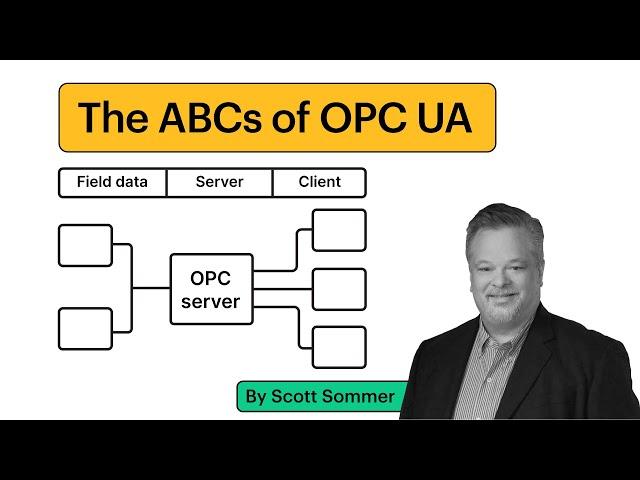
The ABCs of OPC UA: Everything You Need to Understand
▶ The easiest way to learn industrial automation:
https://realpars.com
▶ You can read the full post here:
https://realpars.com/opc-ua-basics/
⌚Timestamps:
00:00 - Intro
00:33 - Key features of OPC UA
04:53 - OPC UA architecture
06:39 - Industry applications
07:57 - Future of OPC UA
08:59 - Summary
OPC Unified Architecture, also known as OPC-UA, was developed in the mid-2000s as a TCP/IP-based protocol with the ability to share data at the control system level in real-time with high reliability and efficiency.
OPC Classic opened the door for control system applications to share data quickly with minimal configuration. It was first released in 1996. This method was based on the Microsoft Distributed Component Object Model or DCOM services for client-server communications.
In order to correct these issues, and to provide a more robust and secure method for exchanging data, the OPC UA architecture, was developed.
OPC UA makes it possible to exchange process data, alarms and events, and historical data all from one client and server application. The original OPC UA specification was released in 2006.
OPC UA is not based upon DCOM, but rather on a protocol stack built on top of the well-known TCP/IP protocol, the backbone of Ethernet, and the internet.
OPC UA is a client-server-based application. The OPC UA server provides access to its data by exposing its data objects to an OPC UA client, such as an HMI application.
The OPC UA interface is defined through configuration. An OPC UA application on the client subscribes to the data objects in the OPC UA server. These subscriptions are comprised of one or more data links to objects in the server that are used to request data from the server.
Each configured OPC UA subscription has properties that request data such as:
- DisplayName, which is the data object or tag,
- Tag Value,
- Quality or Status,
- Timestamp of the OPC UA Server and Client,
- Data Type, and
- Subscription ID
A typical OPC UA subscription link has this format:
“opc.tcp://PCName192.168.1.45:62652/MyOPCProvider/UAServerName”
The OPC UA TCP protocol uses essentially the same link structure as for an internet link. This gives OPC UA clients the ability to directly discover, address, and subscribe to data in the OPC UA server over any Ethernet network.
To use OPC UA in your control system, you need OPC UA Server software to connect to the data sources, such as PLCs, application computers, and HMI stations.
You also need OPC UA Client software to interact with the OPC UA server and to set up subscriptions for periodic data access. This data will be used to store the collected data for use on HMI screens, historical databases, alarm loggers, PLCs, or other applications.
OPC UA is a vital component of the fourth industrial revolution, or Industry 4.0. The Industrial Internet of Things, known as IIoT, is all about access to data and making data available to those users that require it. This is exactly what the OPC UA data subscription feature is all about!
OPC UA is often the only mechanism that HMI systems can access data from vendor-supplied equipment like chillers, boilers, compressors, lab equipment, and single-use pharmaceutical processing skids.
Because OPC UA is based on the TCP/IP Ethernet stack, as Ethernet evolves, so will OPC UA. That means that OPC UA will be able to take advantage of advances in cybersecurity measures such as encryption.
Efforts like the collaboration between OPC UA and TSN (Time-Sensitive Networking) will lead to creating comprehensive solutions by merging the strengths of different technology standards.
OPC UA is positioned to be the cornerstone for IIoT communications solutions for manufacturing systems, providing seamless data integration across devices, machines, and systems.
=============================
If you're eager to dive deeper and truly master OPC UA, don't forget to check out the course, “OPC-UA: Learn the Basics”: https://learn.realpars.com/courses/opc-ua-learn-the-basics
=============================
Did you miss out on the latest and greatest? Catch up now by watching our videos right here:
https://realpars.com/codesys-hmi-interfaces/
https://realpars.com/single-pair-ethernet/
https://realpars.com/codesys-visualization/
=============================
TWEET THIS VIDEO: https://ctt.ac/azb7w
=============================
Follow us on Facebook 👉 https://www.facebook.com/therealpars
Follow us on Twitter 👉 https://twitter.com/realpars
Follow us on LinkedIn 👉 https://www.linkedin.com/company/realpars
Follow us on Instagram 👉 https://www.instagram.com/realparsdotcom
#opcua #Industrialnetworks #RealPars
https://realpars.com
▶ You can read the full post here:
https://realpars.com/opc-ua-basics/
⌚Timestamps:
00:00 - Intro
00:33 - Key features of OPC UA
04:53 - OPC UA architecture
06:39 - Industry applications
07:57 - Future of OPC UA
08:59 - Summary
OPC Unified Architecture, also known as OPC-UA, was developed in the mid-2000s as a TCP/IP-based protocol with the ability to share data at the control system level in real-time with high reliability and efficiency.
OPC Classic opened the door for control system applications to share data quickly with minimal configuration. It was first released in 1996. This method was based on the Microsoft Distributed Component Object Model or DCOM services for client-server communications.
In order to correct these issues, and to provide a more robust and secure method for exchanging data, the OPC UA architecture, was developed.
OPC UA makes it possible to exchange process data, alarms and events, and historical data all from one client and server application. The original OPC UA specification was released in 2006.
OPC UA is not based upon DCOM, but rather on a protocol stack built on top of the well-known TCP/IP protocol, the backbone of Ethernet, and the internet.
OPC UA is a client-server-based application. The OPC UA server provides access to its data by exposing its data objects to an OPC UA client, such as an HMI application.
The OPC UA interface is defined through configuration. An OPC UA application on the client subscribes to the data objects in the OPC UA server. These subscriptions are comprised of one or more data links to objects in the server that are used to request data from the server.
Each configured OPC UA subscription has properties that request data such as:
- DisplayName, which is the data object or tag,
- Tag Value,
- Quality or Status,
- Timestamp of the OPC UA Server and Client,
- Data Type, and
- Subscription ID
A typical OPC UA subscription link has this format:
“opc.tcp://PCName192.168.1.45:62652/MyOPCProvider/UAServerName”
The OPC UA TCP protocol uses essentially the same link structure as for an internet link. This gives OPC UA clients the ability to directly discover, address, and subscribe to data in the OPC UA server over any Ethernet network.
To use OPC UA in your control system, you need OPC UA Server software to connect to the data sources, such as PLCs, application computers, and HMI stations.
You also need OPC UA Client software to interact with the OPC UA server and to set up subscriptions for periodic data access. This data will be used to store the collected data for use on HMI screens, historical databases, alarm loggers, PLCs, or other applications.
OPC UA is a vital component of the fourth industrial revolution, or Industry 4.0. The Industrial Internet of Things, known as IIoT, is all about access to data and making data available to those users that require it. This is exactly what the OPC UA data subscription feature is all about!
OPC UA is often the only mechanism that HMI systems can access data from vendor-supplied equipment like chillers, boilers, compressors, lab equipment, and single-use pharmaceutical processing skids.
Because OPC UA is based on the TCP/IP Ethernet stack, as Ethernet evolves, so will OPC UA. That means that OPC UA will be able to take advantage of advances in cybersecurity measures such as encryption.
Efforts like the collaboration between OPC UA and TSN (Time-Sensitive Networking) will lead to creating comprehensive solutions by merging the strengths of different technology standards.
OPC UA is positioned to be the cornerstone for IIoT communications solutions for manufacturing systems, providing seamless data integration across devices, machines, and systems.
=============================
If you're eager to dive deeper and truly master OPC UA, don't forget to check out the course, “OPC-UA: Learn the Basics”: https://learn.realpars.com/courses/opc-ua-learn-the-basics
=============================
Did you miss out on the latest and greatest? Catch up now by watching our videos right here:
https://realpars.com/codesys-hmi-interfaces/
https://realpars.com/single-pair-ethernet/
https://realpars.com/codesys-visualization/
=============================
TWEET THIS VIDEO: https://ctt.ac/azb7w
=============================
Follow us on Facebook 👉 https://www.facebook.com/therealpars
Follow us on Twitter 👉 https://twitter.com/realpars
Follow us on LinkedIn 👉 https://www.linkedin.com/company/realpars
Follow us on Instagram 👉 https://www.instagram.com/realparsdotcom
#opcua #Industrialnetworks #RealPars
Тэги:
#The_ABCs_of_OPC_UA:_Everything_You_Need_to_Understand #OPC_UA_Basics #The_ABCs_of_OPC_UA #Key_Features_of_OPC_UA #OPC_UA_Subscriptions #OPC_UA_Architecture #OPC_UA_Industry_Applications #Future_of_OPC_UA #What_are_the_basics_of_OPC #OPC_UA_example #OPC_UA_communication #OPC_UA #Industry_4.0 #IIoT #OPC_UA_in_Industry #OPC_UA_Server #OPC_UA_Client #OPC_UA_Security #TCP/IP_Protocol #OPC_UA_and_TSN #OPC_UA_for_Manufacturing #Cybersecurity_in_OPC_UA #IIoT_CommunicationsКомментарии:
Nasty Lil Nigga x Bee Badd
Boogotti Rhames
Я создал свою первую игру и защитил диплом
BGDN [Богдан]
Top Motivational Pictures with Deep Meaning | One Picture Million Words Motivation Part#79
Successes Motivational Pictures
Természetes szárazföldi életközösségek: a mezők és a legelők
Távoktatás magyar nyelven
Инфокрафт: Формула ЖКХ. Индивидуальные приборы учета
VideoInfocraft


























